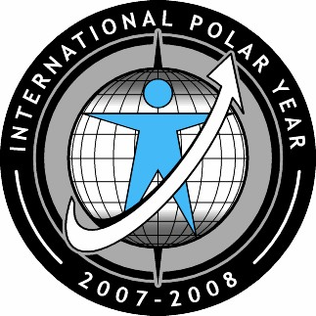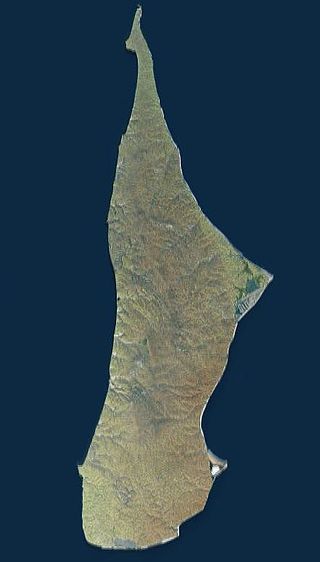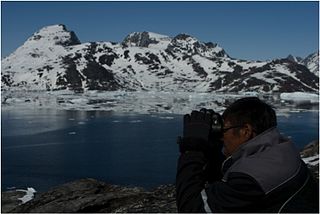Related Research Articles

The International Polar Years (IPY) are collaborative, international efforts with intensive research focus on the polar regions. Karl Weyprecht, an Austro-Hungarian naval officer, motivated the endeavor in 1875, but died before it first occurred in 1882–1883. Fifty years later (1932–1933) a second IPY took place. The International Geophysical Year was inspired by the IPY and was organized 75 years after the first IPY (1957–58). The fourth, and most recent, IPY covered two full annual cycles from March 2007 to March 2009.

The reindeer or caribou is a species of deer with circumpolar distribution, native to Arctic, subarctic, tundra, boreal, and mountainous regions of Northern Europe, Siberia, and North America. It is the only representative of the genus Rangifer. More recent studies suggest the splitting of reindeer and caribou into six distinct species over their range.

Belkovsky Island is the westernmost island of the Anzhu Islands subgroup of the New Siberian Islands archipelago in the Laptev Sea.

The Canadian Wildlife Service or CWS, is a Branch of the Department of Environment and Climate Change Canada, a department of the Government of Canada. November 1, 2012 marked the 65th anniversary of the founding of Service.

The Arctic Council is a high-level intergovernmental forum that addresses issues faced by the Arctic governments and the indigenous people of the Arctic region. At present, eight countries exercise sovereignty over the lands within the Arctic Circle, and these constitute the member states of the council: Canada; Denmark; Finland; Iceland; Norway; Russia; Sweden; and the United States. Other countries or national groups can be admitted as observer states, while organizations representing the concerns of indigenous peoples can be admitted as indigenous permanent participants.
The Arctic Climate Impact Assessment (ACIA) is a study describing the ongoing climate change in the Arctic and its consequences: rising temperatures, loss of sea ice, unprecedented melting of the Greenland ice sheet, and many impacts on ecosystems, animals, and people. The ACIA is the first comprehensively researched, fully referenced, and independently reviewed evaluation of Arctic climate change and its impacts for the region and for the world. The project was guided by the intergovernmental Arctic Council and the non-governmental International Arctic Science Committee. Three hundred scientists participated in the study over a span of three years.

The Porcupine caribou(Rangifer tarandus groenlandicus) is a herd or ecotype of barren-ground caribou, the subspecies of the reindeer or caribou found in Alaska, United States, and Yukon and the Northwest Territories, Canada.

The barren-ground caribou is a subspecies of the reindeer that is found in the Canadian territories of Nunavut and the Northwest Territories, in northern Alaska and in south-western, Greenland. It includes the Porcupine caribou of Yukon and Alaska. The barren-ground caribou is a medium-sized caribou, smaller and lighter-colored than the boreal woodland caribou, with the females weighing around 90 kg (200 lb) and the males around 150 kg (330 lb). However, on some of the smaller islands, the average weight may be less. The large migratory herds of barren-ground caribou take their names from the traditional calving grounds, such as the Ahiak herd, the Baffin Island herds, the Bathurst herd, the Beverly herd, the Bluenose East herd, the Bluenose West herd, the Porcupine herd and the Qamanirjuaq herd.

The International Permafrost Association (IPA), founded in 1983, is an international professional body formed to foster the dissemination of knowledge concerning permafrost and to promote cooperation among individuals and national or international organisations engaged in scientific investigation and engineering work related to permafrost and seasonally frozen ground. The IPA became an Affiliated Organisation of the International Union of Geological Sciences in July 1989.

Reindeer hunting in Greenland is of great importance to the Greenlandic Inuit and sports hunters, both residents and tourists. Reindeer (caribou) are an important source of meat, and harvesting them has always played an important role in the history, culture, and traditions of the Greenlandic Inuit. Controlled hunting is important for the welfare of reindeer, the quality of life for Inuit, both as food, and part of their culture and Greenlandic culture in general, and the preservation of tundra grazing areas. Therefore, scientific research is regularly performed to determine the quotas needed to maintain a proper ecological balance.
Canada's Biodiversity Convention Office (BCO) serves as National Focal Point for the United Nations Convention on Biological Diversity and the Canadian Biodiversity Strategy. BCO also provides a leadership role in the Biodiversity Conservation Working Group of the Commission for Environmental Cooperation and in the Conservation of Arctic Flora and Fauna (CAFF) working group of the Arctic Council.
Although the bulk of its area is covered by ice caps inhospitable to most forms of life, Greenland's terrain and waters support a wide variety of plant and animal species. The northeastern part of the island is the world's largest national park. The flora and fauna of Greenland are strongly susceptible to changes associated with climate change.

The Arctic Environmental Protection Strategy (AEPS) is a multilateral, non-binding agreement among Arctic states on environmental protection in the Arctic. Discussions began in 1989, with the AEPS adopted in June 1991 by Canada, Denmark, Finland, Iceland, Norway, Sweden, the Soviet Union, and the United States. The AEPS deals with monitoring, assessment, protection, emergency preparedness/response, and conservation of the Arctic zone. It has been called a major political accomplishment of the post–Cold War era.
The Wildlife Conservation Society Canada, based in Toronto, Ontario, is the Canadian affiliate of the Wildlife Conservation Society International (WCS), incorporated as a conservation organization in Canada in July 2004. WCS Canada currently runs conservation projects across six key regions in Canada led by its staff of field-based scientists.

The boreal woodland caribou, also known as Eastern woodland caribou, boreal forest caribou and forest-dwelling caribou, is a North American subspecies of reindeer found primarily in Canada with small populations in the United States. Unlike the Porcupine caribou and barren-ground caribou, boreal woodland caribou are primarily sedentary.

Participatory monitoring is the regular collection of measurements or other kinds of data (monitoring), usually of natural resources and biodiversity, undertaken by local residents of the monitored area, who rely on local natural resources and thus have more local knowledge of those resources. Those involved usually live in communities with considerable social cohesion, where they regularly cooperate on shared projects.
Kit Kovacs is a marine mammal researcher, best known for her work on biology, conservation and management of whales and seals. She is based at the Norwegian Polar Institute (NPI), Tromsø and is an Adjunct professor of biology, Marine Biology, at the University Centre in Svalbard (UNIS).
Caribou herds in Canada are discrete populations of seven subspecies that are represented in Canada. Caribou can be found from the High Arctic region south to the boreal forest and Rocky Mountains and from the east to the west coasts.

Jennifer F. Provencher is a Canadian conservation biologist. She is an early-career researcher and a spokesperson for the awareness of plastic contaminants in marine wildlife, pollution and climate change. Many of her work focus on the impact of human activities on the health of Arctic seabirds and marine ecosystems.

The reindeer is a widespread and numerous species in the northern Holarctic, being present in both tundra and taiga. Originally, the reindeer was found in Scandinavia, eastern Europe, Russia, Mongolia, and northern China north of the 50th latitude. In North America, it was found in Canada, Alaska, and the northern contiguous USA from Washington to Maine. In the 19th century, it was apparently still present in southern Idaho. It also occurred naturally on Sakhalin, Greenland, and probably even in historical times in Ireland.
References
- ↑ Eamer, Claire (April 9, 2010), "Caribou show biodiversity within a single species" (PDF), CARMA
- 1 2 About CARMA, CARMA, nd, retrieved December 29, 2016
- 1 2 Joan Eamer; Don Russell, eds. (December 6, 2012), CARMA 8 Moving Forward: Knowledge to Action, Vancouver, BC, Canada: CircumArctic Rangifer Monitoring and Assessment Network, p. 47, retrieved December 29, 2016
- 1 2 About CARMA, CARMA, retrieved December 29, 2016
- ↑ "About CAFF". Conservation of Arctic Flora and Fauna (CAFF).
- 1 2 Krupnik, Igor; Allison, Ian; Bell, Robin; Cutler, Paul; Hik, David; López-Martínez, Jerónimo; Rachold, Volker; Sarukhanian, Eduard; Summerhayes, Colin, eds. (February 2011). Understanding Earth's Polar Challenges: International Polar Year 2007-2008. Summary by the IPY Joint Committee. Rovaniemi, Finland: University of the Arctic and ICSU/WMO Joint Committee for International Polar Year 2007–2008. ISBN 978-1-896445-55-7 . Retrieved 2019-09-12.
- ↑ Barr, Susan; Lüdecke, Cornelia, eds. (2010). The History of the International Polar Years (IPYs). From Pole to Pole. Vol. 1. Berlin, Heidelberg: Springer-Verlag. doi:10.1007/978-3-642-12402-0. ISBN 978-3-642-12401-3.
- ↑ "IPY History". International Polar Year. 4 February 2010.
- ↑ "International Polar Year 2007-2008: A Valuable Opportunity for Canada", Government of Canada, retrieved December 29, 2016
- ↑ Yukon College receives Prestigious research status
- 1 2 Don E. Russell; Anne Gunn; Robert G. White (January 26, 2015), "CircumArctic Collaboration to Monitor Caribou and Wild Reindeer" (PDF), Arctic , 68 (11): 6, doi: 10.14430/arctic4496 , retrieved December 29, 2016
- ↑ Friis-Baastad, Erling (November 29, 2013), "The good-news caribou" (PDF), Yukon Research Centre Yukon College and Environment Yukon
- ↑ Friis-Baastad, Erling (March 22, 2013), "Cars vs. caribou: an avoidable 'harvest'" (PDF), Yukon Research Centre Yukon College and Environment Yukon
- ↑ The Rangifer Anatomy Project: Linking community and scientific approaches to caribou structure and function, Aurora Research Institute, 2009, retrieved December 29, 2016
- ↑ Don Russell (2004), The CARMA Network: Tools and resources (PDF), Vancouver, retrieved December 29, 2016
{{citation}}: CS1 maint: location missing publisher (link) - ↑ Don E. Russell; Paul H. Whitfield; Jing Cai; Anne Gunn; Robert G. White; Kim Poole (2013). "CARMA's MERRA-based caribou range climate database". Rangifer . 33 (21): 145–151. doi: 10.7557/2.33.2.2535 . Retrieved 2023-06-24.
- ↑ 16th North American Caribou Workshop (PDF). Thunder Bay, Ontario. May 16–20, 2016. Archived from the original (PDF) on 2017-01-19. Retrieved December 29, 2016.